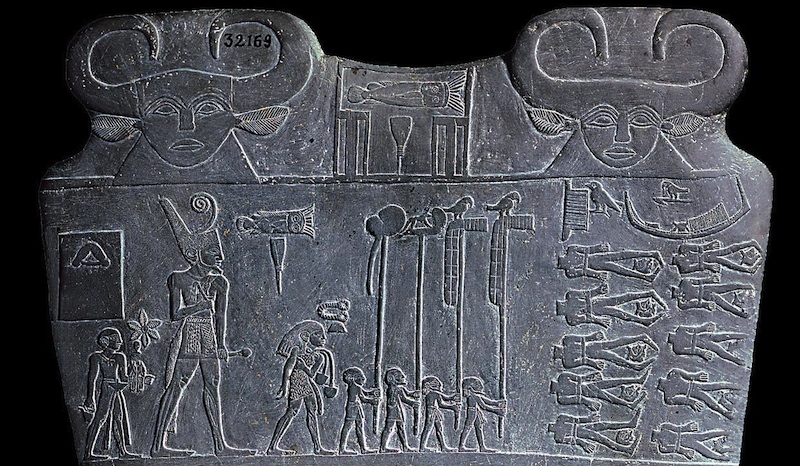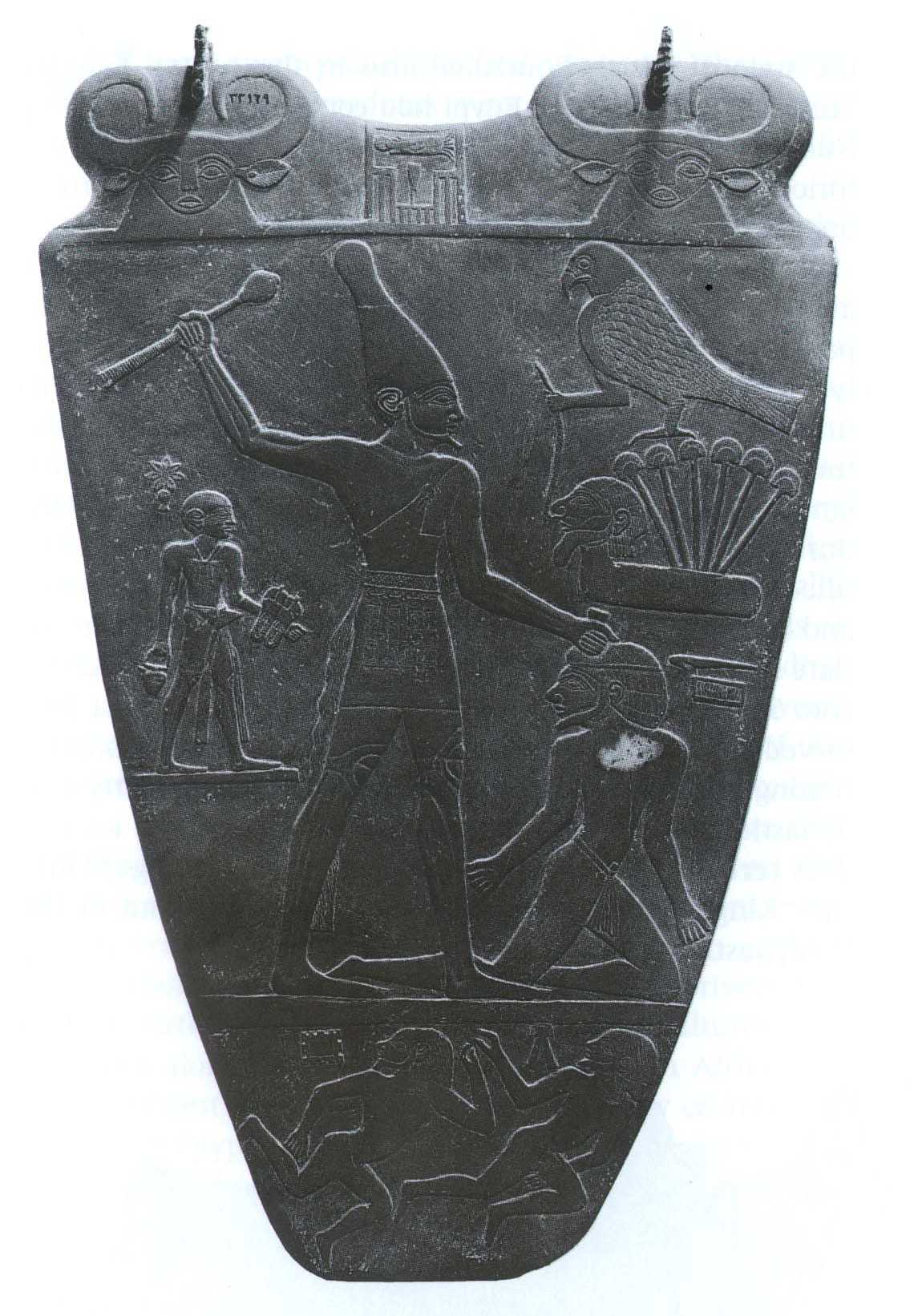Describe Palette as It Has Been Used in Egyptian Sculpture
The Narmer Palette is a significant Egyptian archaeological find which could have produced around the 31st century BC. The Palette uses both active and inactive lines Carroll 56.

Palette Of King Narmer Smarthistory
This palette was discovered in 1898 in the temple of falcon god Horus with some other objects that had been used for ceremonial purposes and then ritually buried.

. It shows visual conventions of the time such as size which signifies importance the use of mathematical formulas to determine proportions and the way in which. Society this object visualizes and commemorates the unification of Upper and Lower Egypt and the beginning of Dynastic Egypt. Head in profile eye full frontal shoulders full frontal with distinct collar bones arms in profile hand does not appear as a hand but as a symbol for a hand upper chest side view with one nipple navel three quarters.
5500 4000 BCE. The surface of the palette has been divided into horizontal bands or registers and each figure stands on a line or strip denoting the ground. One of the core elements of designs that have been appropriated is a line.
This tomb shows how the Egyptians probably viewed it as being a sort of. The ankh provided the key to the gates of death and what lay beyond. They were most often used as grave markers that contained carvings andor paintings of the tomb owner often with his family and inscriptions of prayers to various gods of the dead.
The temple was built as if it were the tomb or eternal resting-place of a divinity whose statue was hidden within a succession of closed halls opened to view only for a short time when the sun or moon or particular star reached a point on the. The statues of the Sphinx were made of. The Narmer Palette c.
There is a scene is depicted in this pallet showing a king who is identified. It is also known as the the Great Hierakonpolis Palette or the Palette of Narmer. Show transcribed image text Expert Answer.
Inactive lines divide the representation into various segments with different. This is considered to be a ceremonial object in the Egyptian civilization. They look remarkably like tombstones because tombstones are a modern manifestation of these kinds of markers.
They were used to grind pigments such as malachite or galena from which. Who are the experts. Most of the sculptures that have been found by scientists were found in Pharaonic tombs some of them are even an authentic portrait of their deceased.
The Sphinx is a synonym for the word secret which in ancient Egyptian religion means a lion with a human body perhaps a mystery or secret throughout its history built in the time of King Chephren the guardian of the gates of the underworld. The Egyptian expression for stelae wd generally means monument of any kind. The Narmer Palette is a 63-centimetre-tall 207 ft shield-shaped ceremonial palette carved from a single piece of flat soft dark gray-green siltstoneThe stone has often been wrongly identified in the past as being slate or schistSlate is layered and prone to flaking and schist is a metamorphic rock containing large randomly distributed mineral grains.
Sculpture in ancient Egypt for the statue of the Sphinx. The figures in the tomb were drawn according to a convention that was well established first shown on the Narmer palette. 29502775 BCE is a great place to start discussion in a class on Ancient Egypt as it highlights some key ideas.
Most Egyptian sculpture was created during the early dynastic period. Briefly describe the ancient Egyptian Sculpture. The ankh was the sign of life that indicated the power to give or take away life and could not be carried by ordinary Egyptians.
This type of sculpture does not present any kind of sentimental expression in its factions nor any type of movement. Egyptian tombs required the widest use of sculpture. On the left it shows the white crown of Upper Egypt and the red crown of Lower Egypt on the right.
It also played a historical and memorial. Sculptures were typically carved as both sunken and low reliefs as they adhered to the same conventions that governed Egyptian painting and were able to withstand the force of the sun. The Narmer Palette announced the unification of Upper and Lower Egypt.
Ancient Egyptian sculpture was closely connected with Egyptian architecture and mainly concerned temples and funeral tombs. The active lines bring out the form of the carvings for example of King Narmer the serpopard etc. Great Sphinx of Giza Great Sphinx of Giza is a limestone statue of reclining sphinx.
Experts are tested by Chegg as specialists in their subject area. What strikes us first is its strong sense of order. It is about 2 feet in height carved grey siltstone pallet.
Ancient Egyptian religion has many gods and symbols and among them some were only associated with the king or queen. The only exceptions are the attendants of. This problem has been solved.
We review their content and use your feedback to keep the quality high. In addition this type of prehistoric sculpture included statues of civil servants and scribes as well as groups. Ancient Egyptian sculpture was closely associated with Egyptian architecture and mostly concerned the temple and the funeral tomb.
This type of sculpture focuses mainly on funerary aspects of Egyptian people. Egyptian Sculpture Main Points. In these pits portrait statues of the deceased pharaoh were installed.
The political and social hierarchies Narmer is huge hieratic scale leadership and status. Many of them represented gods. Range in size- tiny jewelry to massive stone sculptures Sculptures of pharaohs are meant to impress and overwhelm Individualization and sophistication are sacrificed for monumentality and grandeur Limestone sandstone gypsum used easy to carve Wooden sculptures are painted Copper and iron also used Sculpture.
Granite is viewed as kind sort of a minor luxury material usually used in home kitchens. It has mainly some significant ancient inscriptions. See the answer See the answer See the answer done loading.
LOGIC OF EGYPTIAN STYLE. This sculpture is called The Narmer Palette. Figures who are not seated in sculptures were characteristically portrayed with parted.
The new inner logic of the Narmer palettes style becomes readily apparent in contrast to the predynastic wall painting. Portrait sculpture began in Egypt where the Narmer Palette shows a ruler of the 32nd century BCE and Mesopotamia where we have 27 surviving statues of Gudea who ruled Lagash c. Predynastic Palettes of Ancient Egypt f Predynastic Palettes of Ancient Egypt Cosmetic and Votive palettes Cosmetic palettes usually of siltstone greywacke have been found in the form of grave goods in cemeteries as early as the Badarian period c.
In ancient Egypt sculpture was not only for fun and entertainment but it had a functional and environmental role that had to do with the customs traditions and rituals within an integrated aesthetic design. The Palette of King Narmer exhibits several expressive visual qualities.


Comments
Post a Comment